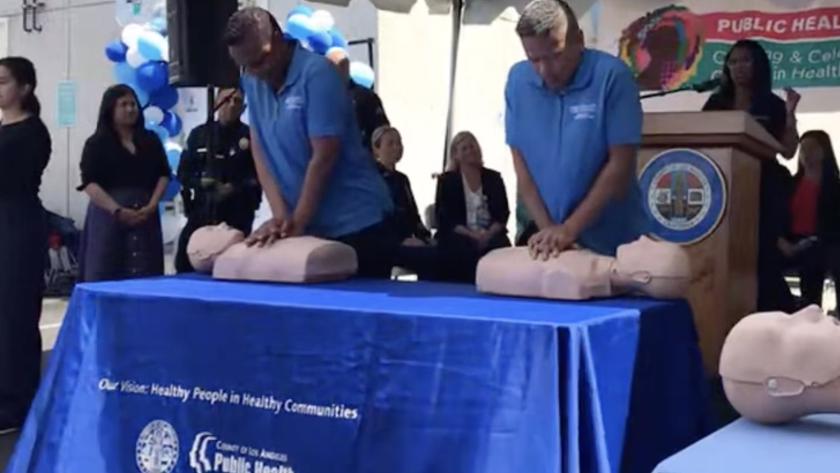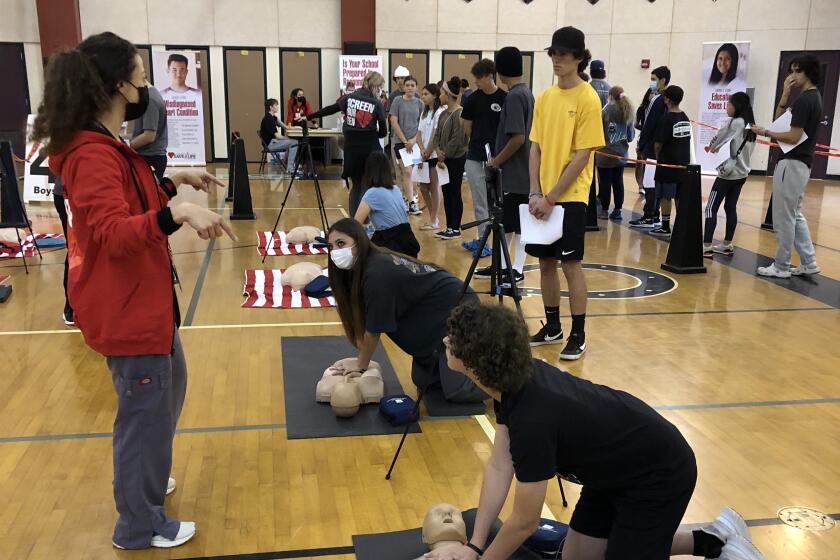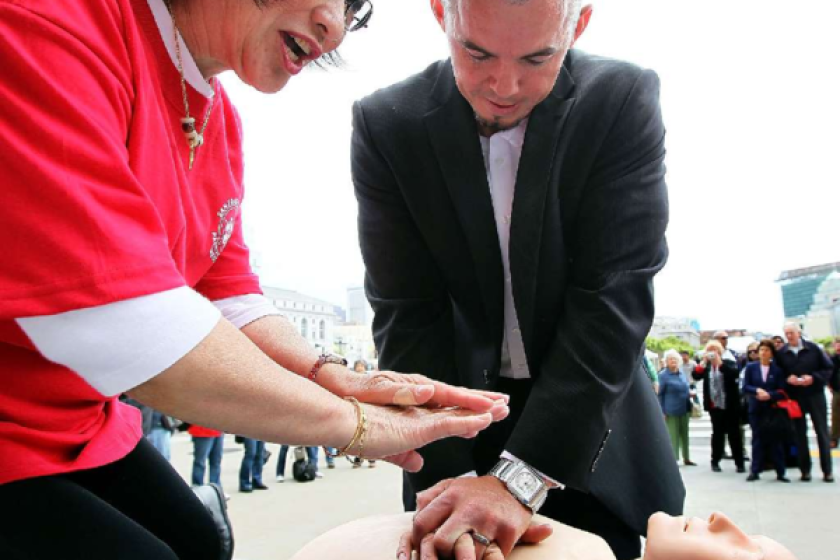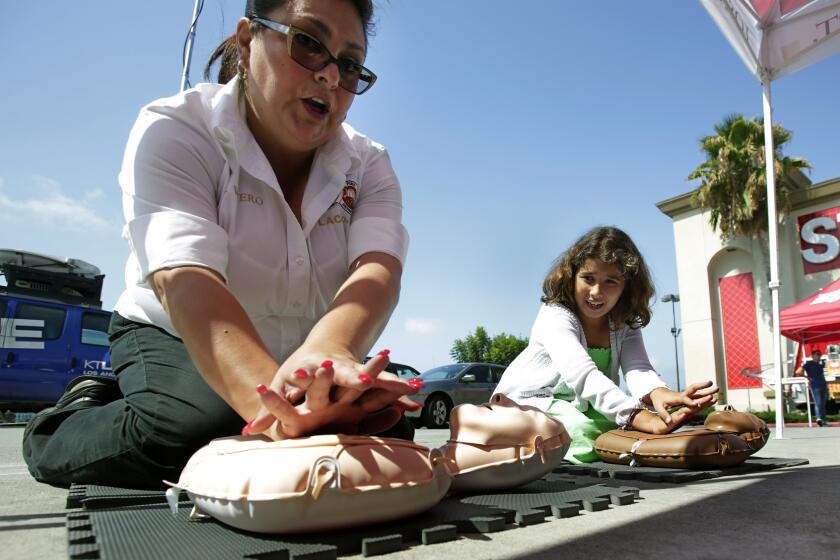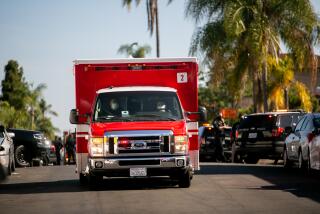Mouth-to-mouth CPR makes some reluctant to render aid. L.A. now pushing an alternative
- Share via
As data emerges that learning hands-only CPR can arguably be far more important than standard CPR, officials in Los Angeles County are stepping up efforts to train half a million Angelenos on how to do CPR without mouth-to-mouth contact.
- Share via
When it comes to promoting the use of hands-only CPR, Los Angeles County officials aren’t saving their breath.
That potentially life-saving step is now at the heart of a campaign to train half a million Angelenos on how to aid someone suffering from cardiac arrest without using mouth-to-mouth contact.
“With CPR, a victim’s chances of survival double or even triple, particularly if we’re able to provide that CPR immediately. So this simple tool, this simple skill ... will keep people alive until they can get medical attention,” county Public Health Director Barbara Ferrer said at a recent news conference.
Many are likely aware of CPR, short for cardiopulmonary resuscitation, and have at least a rough idea of how to perform it. The familiar two-pronged approach involves both rhythmically pressing on a person’s chest and using your mouth to breathe into the victim and provide additional oxygen.
But officials and experts say some bystanders may hesitate to intervene because they’re uncomfortable with the idea of mouth-to-mouth contact. And those seconds can be precious to someone suffering from cardiac arrest, when the heart suddenly stops pumping.
“Knowing how to provide hands-only CPR can help save a loved one’s life while firefighters, lifeguards and deputies are on their way,” L.A. County Fire Chief Anthony Marrone said during last week’s news conference.
The collapse of an NFL player during Monday night’s game has spurred interest in how to give life-saving aid to people in cardiac arrest. Classes abound in Southern California.
Studies suggest a higher percentage of bystanders are more willing to perform CPR if it doesn’t involve mouth-to-mouth contact. And the hands-only method can keep blood pumping through the heart until paramedics arrive.
The county Department of Public Health has set a goal to teach 500,000 residents and workers how to perform hands-only CPR by the end of this year. That figure is a major expansion from the 2019 “L.A. County Heart Heroes” campaign in 2019, which set a goal of 100,000.
Workshops will be held throughout the year at sporting events, entertainment venues, places of worship, schools, colleges, work sites and malls. More resources and information on upcoming sessions is available online.
“It clearly saves lives. So be part of the solution ... be a soldier in improving the life and health of your family and your community,” said Dr. Marianne Gausche-Hill, medical director for the county Emergency Medical Services Agency.
Compression-only CPR found effective
Heart disease is the leading cause of death nationwide, and about 90% of people who suffer cardiac arrest outside a hospital setting will die.
About 70% of cardiac arrests that occur outside the hospital happen in the home, Ferrer said, “so knowing how to give CPR in an emergency means you’re prepared to save the lives of the people you love.”
There are about 8,000 reported cardiac arrests in L.A. County annually, according to Gausche-Hill. But officials noted that the rate at which bystanders administer CPR has increased notably as of late — from 12% five years ago to almost 49% countywide more recently.
Hands-only CPR can still be quite effective because an adult who suddenly collapses from cardiac arrest typically has enough oxygen to keep their body in decent shape for the first few minutes, according to the American Heart Assn.
“Providing chest compressions that are hard and fast enough will help pump blood to the heart and brain,” the association says. “Studies have shown that hands-only CPR is just as effective as conventional CPR with breaths when given in the first few minutes.”
A nationwide effort to promote CPR appears to have boosted survival rates for people who went into cardiac arrest in their homes, offices, grocery stores, movie theaters or anywhere else that wasn’t a hospital, new research shows.
Even trained rescuers may begin performing conventional CPR slower than laypeople trained only to do hands-only CPR, according to some studies.
“This can be explained by the additional cognitive or emotional burdens associated with attempting the more complex psychomotor task of traditional CPR,” according to an advisory from the American Heart Assn.
If you suspect someone has suffered a cardiac arrest, health officials recommend a three-step response:
- Tap the victim on the shoulder and ask if they are OK.
- If they’re not breathing, ask someone to call 911. If no one else is there, call 911.
- Start chest compressions: Place your hands in the center of the victim’s chest, directly between the nipples. Anchor your entire body weight on the person so you can have enough leverage to press down at least two inches. Start pressing down, very fast, at a rate of 100 to 120 beats per minute, said L.A. County public health nurse Angela Austin.
Hoping to turn regular cellphone-toting Angelenos into rapid responders, the Los Angeles County Fire Department has linked its dispatch system to a cellphone app that will notify CPR-trained good Samaritans when someone in a public place nearby is having a cardiac arrest.
Some familiar songs can help you keep a pace of 100 to 120 beats per minute.
One example is the Bee Gees’ “Stayin’ Alive,” which was featured in an episode of the sitcom “The Office.” A 21-year-old remembered that scene when he found an unresponsive woman in Arizona, and, despite having never been trained in CPR, performed chest compression that may have saved the woman’s life, according to the Arizona Daily Star.
A more comprehensive song list is posted on the American Heart Assn. website. The organization has also curated options in a Spotify playlist.
They include songs like Carly Rae Jepsen’s “Call Me Maybe,” Lady Gaga’s “Poker Face,” Diana Ross’ “Ain’t No Mountain High Enough,” Spice Girls’ “Wannabe,” Smash Mouth’s “All Star,” Whitney Houston’s “I Wanna Dance With Somebody,” Michael Jackson’s “Billie Jean,” Los Del Rio’s “Macarena,” ’N Sync’s “Bye Bye Bye,” Survivor’s “Eye of the Tiger,” Bruno Mars’ “Grenade,” Johnny Cash’s “Ring of Fire,” Adele’s “Rolling in the Deep” and Janet Jackson’s “Rhythm Nation.”
More to Read
Sign up for Essential California
The most important California stories and recommendations in your inbox every morning.
You may occasionally receive promotional content from the Los Angeles Times.
